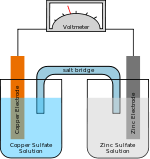Silicon–air battery
Silicon–air batteries are a new battery technology invented by a team led by Prof. Ein-Eli at the Grand Technion Energy Program at the Technion – Israel Institute of Technology.
Silicon–air batteries are created from oxygen and silicon. Such batteries would be lightweight, and have a high tolerance for both extremely dry conditions and high humidity and would provide significant savings in cost and weight because the built-in cathode of conventional batteries is not present in silicon–air batteries.[1][2] The experimental cells described in the journal Electrochemistry Communications using a room-temperature ionic liquid as electrolyte produced between 1 and 1.2 volts at a current density of 0.3 millamperes per square centimeter of silicon.[3]
References
- ↑ Silicon–Air Battery: Non-stop Power for Thousands of Hours
- ↑ Green Living Ideas
- ↑ http://www.sciencedirect.com/science/article/pii/S1388248109003889 Abstract of paper Silicon–air batteries , Volume 11, Issue 10, October 2009, Pages 1916-1918 in Electrochemistry Communications, retrieved 2011 Aug 3
| ||||||||||||||||||||||||||||||||||||||||||||||||||||
